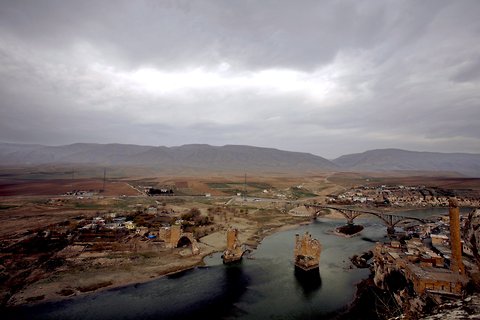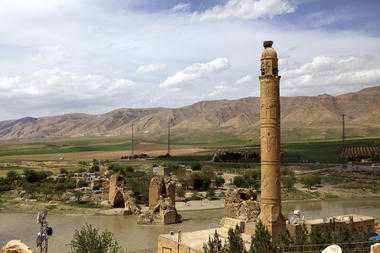Flooding out terror? Turkey’s Ilisu dam project
Editor’s Note: Soner Cagaptay is a senior fellow and Altay Sedat Otun is a research intern at the Washington Institute for Near East Policy.
By Soner Cagaptay and Altay Sedat Otun – Special to CNN

You may have heard of dams being built for water management purposes or electricity production, but probably not one being built for counter-terrorism purposes. Turkey’s proposed Ilisu Dam on the Tigris River would satisfy just that end.
When Ankara completes the proposed construction on the dam in 2013, a large artificial reservoir would flood canyons across the rugged terrain of southeastern Turkey, thus effectively flooding out the Kurdistan Workers party (PKK) from the area and scoring a rare “hydro-victory” against terrorism.
The Ilisu Dam project is part of the government-funded Southeastern Anatolia Project (GAP), which traces its origins to the early days of the Turkish republic when plans to utilize the Euphrates and Tigris rivers for energy generation and irrigation were first developed. However, GAP it still awaiting completion. Major fighting between the PKK and the Turkish military has prevented completion of the project since the 1990s.
The PKK has enjoyed a great deal of sway in southeastern Turkey, using the mountainous terrain to their advantage in order to smuggle its members into Turkey from camps in Iraq. This area, which one of the authors visited, is pierced by canyons that run for tens of miles and are hundreds of feet deep. These canyons are almost impossible to properly monitor with a military force and form an effective land bridge between Iraq and Turkey that the PKK have used for decades.
In fact, it would not be exaggerated to describe these canyons as sort of a “PKK highway”; a member of the group can enter one of these canyons in Iraq and literally walk hundreds of miles deep into Turkish territory undetected.
Now this could all change: the large artificial lake to be created by the construction of the Ilisu dam would flood these canyons, blocking the “PKK highway.”
Perhaps not so fast. Soon after work on the dam began in 1997, however, the consortium of Swiss, German, and Austrian banks financing the dam began voicing their concerns with the project and withdrew their monetary support. In late 2008, the European members of the Ilisu Dam consortium put a six-month freeze on financing because the project “failed to meet World Bank standards for environmental and cultural protection.”
The World Bank raised concerns over the Ilisu dam project because it would flood the historic Tigris River town of Hasankeyf, which was once an important stop on the Silk Road connecting Asia to Europe. This town also serves as a source of income for the over 3,000 residents who depend on the 2 million tourists who visit the site every year.
Some Turkish activists have even tried for some years to have Hasankeyf added to UNESCO’s World Heritage list, but this would require the Ankara government’s signature, which has been unattainable. Some Turks have also taken the issue to the courts and attempted to establish that Hasankeyf is protected by Turkish laws on the preservation of historical and cultural sites and therefore under the protection of the European Convention on the Protection of the Archaeological Heritage due to Turkey’s signatory status.
In order to alleviate concerns raised by the World Bank, its European Union partners, and the area’s residents, the Turkish government has proposed moving 12 of Hasankeyf’s 300 monuments to a newly created cultural park about a mile north of the city. Turkish government officials have also proposed the construction of Yeni (new) Hasankeyf in order to relocate the area’s over 3,000 residents.
Ankara argues that the dam should be built for it would bring prosperity to the country’s poorest region; by providing water for otherwise dry but fertile lands along the Tigris. The Ilisu Dam would also prove to be an important source for domestic energy production. Due to a growing economy, Turkish energy consumption has risen by 46% since the year 2000. When complete, the Ilisu Dam will have a capacity of 1,200 MW, making it Turkey’s fourth largest dam in size, and second biggest in generative capacity. Yet, in all truth, the dam’s counter-terrorism potential appears perhaps far more useful and valuable to Ankara.
For Turkey, the construction of the Ilisu Dam will kill two birds with one stone. It will help develop the largely poverty stricken southeast corner of Turkey, generate cheap domestic energy, and most importantly cut off a vital land route used by the PKK between their bases in Iraq and Turkish city centers.
For its opponents, the dam is viewed as the ax that will sever the head of the historic town of Hasankeyf and displace thousands of Kurds in a region that is already dealing with rising ethnic tensions. What is yet to be seen, however, is whether Ankara will be successful in its attempt to relocate ancient monuments and properly relocate and compensate the civilian population that will be displaced as a result of the dam.
Then, the Ilisu Dam project could enter the annals of counter-terrorism as the first case of using water to defeat terrorism.
The views expressed in this article are solely those of Soner Cagaptay and Altay Sedat Otun.
via Flooding out terror? Turkey’s Ilisu dam project – Global Public Square – CNN.com Blogs.



